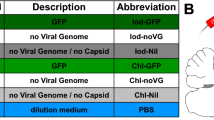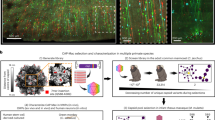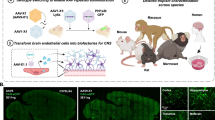Abstract
We recently developed adeno-associated virus (AAV) capsids to facilitate efficient and noninvasive gene transfer to the central and peripheral nervous systems. However, a detailed protocol for generating and systemically delivering novel AAV variants was not previously available. In this protocol, we describe how to produce and intravenously administer AAVs to adult mice to specifically label and/or genetically manipulate cells in the nervous system and organs, including the heart. The procedure comprises three separate stages: AAV production, intravenous delivery, and evaluation of transgene expression. The protocol spans 8 d, excluding the time required to assess gene expression, and can be readily adopted by researchers with basic molecular biology, cell culture, and animal work experience. We provide guidelines for experimental design and choice of the capsid, cargo, and viral dose appropriate for the experimental aims. The procedures outlined here are adaptable to diverse biomedical applications, from anatomical and functional mapping to gene expression, silencing, and editing.
This is a preview of subscription content, access via your institution
Access options
Access Nature and 54 other Nature Portfolio journals
Get Nature+, our best-value online-access subscription
$29.99 / 30 days
cancel any time
Subscribe to this journal
Receive 12 print issues and online access
$259.00 per year
only $21.58 per issue
Buy this article
- Purchase on Springer Link
- Instant access to full article PDF
Prices may be subject to local taxes which are calculated during checkout








Similar content being viewed by others
Change history
16 July 2019
During the production process, the authors of this paper supplied revised versions of Figs. 2–5, Supplementary Tables 1–4, and Supplementary Videos 1–3, but because of publisher error, these revised items were not included in the final published version of the protocol. The figures have been updated in the PDF and HTML versions of the paper, and the revised Supplementary Information files are now available online. We note that the figures have been revised to improve their resolution only; the content of the figures and the data reflected remain unchanged. Also, print requirements impose some limits on figure resolution, but the authors have made very high-resolution versions of Figs. 2–5 available at as Source data.
References
Samulski, R. J. & Muzyczka, N. AAV-mediated gene therapy for research and therapeutic purposes. Annu. Rev. Virol. 1, 427–451 (2014).
Chan, K. Y. et al. Engineered AAVs for efficient noninvasive gene delivery to the central and peripheral nervous systems. Nat. Neurosci. 20, 1172–1179 (2017).
Deverman, B. E. et al. Cre-dependent selection yields AAV variants for widespread gene transfer to the adult brain. Nat. Biotechnol. 34, 204–209 (2016).
Bedbrook, C. N., Deverman, B. E. & Gradinaru, V. Viral strategies for targeting the central and peripheral nervous systems. Annu. Rev. Neurosci. 41, 323–348 (2018).
Reed, S. E., Staley, E. M., Mayginnes, J. P., Pintel, D. J. & Tullis, G. E. Transfection of mammalian cells using linear polyethylenimine is a simple and effective means of producing recombinant adeno-associated virus vectors. J. Virol. Methods 138, 85–98 (2006).
Wright, J. F. Transient transfection methods for clinical adeno-associated viral vector production. Hum. Gene Ther. 20, 698–706 (2009).
Xiao, X., Li, J. & Samulski, R. J. Production of high-titer recombinant adeno-associated virus vectors in the absence of helper adenovirus. J. Virol. 72, 2224–2232 (1998).
Ayuso, E. et al. High AAV vector purity results in serotype- and tissue-independent enhancement of transduction efficiency. Gene Ther. 17, 503–510 (2010).
Grieger, J. C., Choi, V. W. & Samulski, R. J. Production and characterization of adeno-associated viral vectors. Nat. Protoc. 1, 1412–1428 (2006).
Zolotukhin, S. et al. Recombinant adeno-associated virus purification using novel methods improves infectious titer and yield. Gene Ther. 6, 973–985 (1999).
Gray, S. J. et al. Production of recombinant adeno-associated viral vectors and use in in vitro and in vivo administration. Curr. Protoc. Neurosci. 57, Chapter 4, Unit 4.17 (2011).
Yardeni, T., Eckhaus, M., Morris, H. D., Huizing, M. & Hoogstraten-Miller, S. Retro-orbital injections in mice. Lab Anim. 40, 155–160 (2011).
Lerner, T. N. et al. Intact-brain analyses reveal distinct information carried by SNc dopamine subcircuits. Cell 162, 635–647 (2015).
Tervo, D. G. R. et al. A designer AAV variant permits efficient retrograde access to projection neurons. Neuron 92, 372–382 (2016).
Cai, D., Cohen, K. B., Luo, T., Lichtman, J. W. & Sanes, J. R. Improved tools for the Brainbow toolbox. Nat. Methods 10, 540–547 (2013).
Morabito, G. et al. AAV-PHP.B-mediated global-scale expression in the mouse nervous system enables GBA1 gene therapy for wide protection from synucleinopathy. Mol. Ther. 25, 2727–2742 (2017).
Zelikowsky, M. et al. The neuropeptide Tac2 controls a distributed brain state induced by chronic social isolation stress. Cell 173, 1265–1279.e19 (2018).
Allen, W. E. et al. Global representations of goal-directed behavior in distinct cell types of mouse neocortex. Neuron 94, 891–907 (2017).
Hillier, D. et al. Causal evidence for retina-dependent and -independent visual motion computations in mouse cortex. Nat. Neurosci. 20, 960–968 (2017).
Chang, R. B., Strochlic, D. E., Williams, E. K., Umans, B. D. & Liberles, S. D. Vagal sensory neuron subtypes that differentially control breathing. Cell 161, 622–633 (2015).
Williams, E. K. et al. Sensory neurons that detect stretch and nutrients in the digestive system. Cell 166, 209–221 (2016).
Bruegmann, T. et al. Optogenetic control of heart muscle in vitro and in vivo. Nat. Methods 7, 897–900 (2010).
Guettier, J. M. et al. A chemical-genetic approach to study G protein regulation of beta cell function in vivo. Proc. Natl. Acad. Sci. USA 106, 19197–19202 (2009).
Jain, S. et al. Chronic activation of a designer G(q)-coupled receptor improves beta cell function. J. Clin. Invest. 123, 1750–1762 (2013)..
Li, J. H. et al. A novel experimental strategy to assess the metabolic effects of selective activation of a G(q)-coupled receptor in hepatocytes in vivo. Endocrinology 154, 3539–3551 (2013).
Gradinaru, V. Overriding sleep. Science 358, 457 (2017).
Robinson, J. E. & Gradinaru, V. Dopaminergic dysfunction in neurodevelopmental disorders: recent advances and synergistic technologies to aid basic research. Curr. Opin. Neurobiol. 48, 17–29 (2018).
Jackson, K. L., Dayton, R. D., Deverman, B. E. & Klein, R. L. Better targeting, better efficiency for wide-scale neuronal transduction with the synapsin promoter and AAV-PHP.B. Front. Mol. Neurosci. 9, 116 (2016).
Giannelli, S. G. et al. Cas9/sgRNA selective targeting of the P23H Rhodopsin mutant allele for treating retinitis pigmentosa by intravitreal AAV9.PHP.B-based delivery. Hum. Mol. Genet. 27, 761–779 (2018).
Ran, F. A. et al. In vivo genome editing using Staphylococcus aureus Cas9. Nature 520, 186–191 (2015).
Yang, Y. et al. A dual AAV system enables the Cas9-mediated correction of a metabolic liver disease in newborn mice. Nat. Biotechnol. 34, 334–338 (2016).
Senis, E. et al. CRISPR/Cas9-mediated genome engineering: an adeno-associated viral (AAV) vector toolbox. Biotechnol. J. 9, 1402–1412 (2014).
Yang, Q. et al. AAV-based shRNA silencing of NF-kappaB ameliorates muscle pathologies in mdx mice. Gene Ther. 19, 1196–1204 (2012).
Kotterman, M. A. & Schaffer, D. V. Engineering adeno-associated viruses for clinical gene therapy. Nat. Rev. Genet. 15, 445–451 (2014).
Choi, J. H. et al. Optimization of AAV expression cassettes to improve packaging capacity and transgene expression in neurons. Mol. Brain 7, 17 (2014).
Paterna, J. C., Moccetti, T., Mura, A., Feldon, J. & Bueler, H. Influence of promoter and WHV post-transcriptional regulatory element on AAV-mediated transgene expression in the rat brain. Gene Ther. 7, 1304–1311 (2000).
Xu, R. et al. Quantitative comparison of expression with adeno-associated virus (AAV-2) brain-specific gene cassettes. Gene Ther. 8, 1323–1332 (2001).
de Leeuw, C. N. et al. rAAV-compatible MiniPromoters for restricted expression in the brain and eye. Mol. Brain 9, 52 (2016).
Gray, S. J. et al. Optimizing promoters for recombinant adeno-associated virus-mediated gene expression in the peripheral and central nervous system using self-complementary vectors. Hum. Gene Ther. 22, 1143–1153 (2011).
Chamberlain, K., Riyad, J. M. & Weber, T. Expressing transgenes that exceed the packaging capacity of adeno-associated virus capsids. Hum. Gene Ther. Methods 27, 1–12 (2016).
Broderick, J. A. & Zamore, P. D. MicroRNA therapeutics. Gene Ther. 18, 1104–1110 (2011).
Xie, J. et al. MicroRNA-regulated, systemically delivered rAAV9: a step closer to CNS-restricted transgene expression. Mol. Ther. 19, 526–535 (2011).
Nayak, S. & Herzog, R. W. Progress and prospects: immune responses to viral vectors. Gene Ther. 17, 295–304 (2010).
Gao, K. et al. Empty virions in AAV8 vector preparations reduce transduction efficiency and may cause total viral particle dose-limiting side effects. Mol. Ther. Methods Clin. Dev. 1, 9 (2014).
Mingozzi, F. & High, K. A. Immune responses to AAV vectors: overcoming barriers to successful gene therapy. Blood 122, 23–36 (2013).
Strobel, B., Miller, F. D., Rist, W. & Lamla, T. Comparative analysis of cesium chloride- and iodixanol-based purification of recombinant adeno-associated viral vectors for preclinical applications. Hum. Gene Ther. Methods 26, 147–157 (2015).
Rincon, M. Y. et al. Widespread transduction of astrocytes and neurons in the mouse central nervous system after systemic delivery of a self-complementary AAV-PHP.B vector. Gene Ther. 25, 83–92 (2018).
Hordeaux, J. et al. The neurotropic properties of AAV-PHP.B are limited to C57BL/6J mice. Mol. Ther. 26, 664-668 (2018).
Dayton, R. D., Grames, M. S. & Klein, R. L. More expansive gene transfer to the rat CNS: AAV PHP.EB vector dose-response and comparison to AAV PHP.B. Gene Ther. 25, 392-400 (2018).
Gray, S. J. et al. Preclinical differences of intravascular AAV9 delivery to neurons and glia: a comparative study of adult mice and nonhuman primates. Mol. Ther. 19, 1058–1069 (2011).
Chakrabarty, P. et al. Capsid serotype and timing of injection determines AAV transduction in the neonatal mice brain. PLoS ONE 8, e67680 (2013).
Maguire, C. A. et al. Mouse gender influences brain transduction by intravascularly administered AAV9. Mol. Ther. 21, 1469–1470 (2013).
Chen, Y. H., Chang, M. & Davidson, B. L. Molecular signatures of disease brain endothelia provide new sites for CNS-directed enzyme therapy. Nat. Med. 15, 1215–1218 (2009).
Powell, S. K., Rivera-Soto, R. & Gray, S. J. Viral expression cassette elements to enhance transgene target specificity and expression in gene therapy. Discov. Med. 19, 49–57 (2015).
Franks, K. M. et al. Recurrent circuitry dynamically shapes the activation of piriform cortex. Neuron 72, 49–56 (2011).
Resendez, S. L. et al. Visualization of cortical, subcortical and deep brain neural circuit dynamics during naturalistic mammalian behavior with head-mounted microscopes and chronically implanted lenses. Nat. Protoc. 11, 566–597 (2016).
Treweek, J. B. et al. Whole-body tissue stabilization and selective extractions via tissue-hydrogel hybrids for high-resolution intact circuit mapping and phenotyping. Nat. Protoc. 10, 1860–1896 (2015).
Mahmood, T. & Yang, P. C. Western blot: technique, theory, and trouble shooting. N. Am. J. Med. Sci. 4, 429–434 (2012).
Greenbaum, A., Jang, M. J., Challis, C. & Gradinaru, V. Q&A: How can advances in tissue clearing and optogenetics contribute to our understanding of normal and diseased biology? BMC Biol. 15, 87 (2017).
Yang, B. et al. Single-cell phenotyping within transparent intact tissue through whole-body clearing. Cell 158, 945–958 (2014).
Richardson, D. S. & Lichtman, J. W. Clarifying tissue clearing. Cell 162, 246–257 (2015).
Gradinaru, V., Treweek, J., Overton, K. & Deisseroth, K. Hydrogel-tissue chemistry: principles and applications. Annu. Rev. Biophys. 47, 355–376 (2018).
Treweek, J. B. & Gradinaru, V. Extracting structural and functional features of widely distributed biological circuits with single cell resolution via tissue clearing and delivery vectors. Curr. Opin. Biotechnol. 40, 193–207 (2016).
Hama, H. et al. ScaleS: an optical clearing palette for biological imaging. Nat. Neurosci. 18, 1518–1529 (2015).
Day, R. N. & Davidson, M. W. The fluorescent protein palette: tools for cellular imaging. Chemi. Soc. Rev. 38, 2887–2921 (2009).
Gray, D. A. & Woulfe, J. Lipofuscin and aging: a matter of toxic waste. Sci. Aging Knowledge Environ. 2005, re1 (2005).
Kupferschmidt, D. A., Cody, P. A., Lovinger, D. M. & Davis, M. I. Brain BLAQ: post-hoc thick-section histochemistry for localizing optogenetic constructs in neurons and their distal terminals. Front. Neuroanat. 9, 6 (2015).
Petri, K. et al. Comparative next-generation sequencing of adeno-associated virus inverted terminal repeats. Biotechniques 56, 269–273 (2014).
Masters, J. R. & Stacey, G. N. Changing medium and passaging cell lines. Nat. Protoc. 2, 2276–2284 (2007).
JoVE Science Education Database. Anesthesia induction and maintenance. Lab Animal Research. https://www.jove.com/science-education/10263/anesthesia-induction-and-maintenance (2018).
Huang, X. et al. AAV2 production with optimized N/P ratio and PEI-mediated transfection results in low toxicity and high titer for in vitro and in vivo applications. J. Virol. Methods 193, 270–277 (2013).
Lock, M. et al. Rapid, simple, and versatile manufacturing of recombinant adeno-associated viral vectors at scale. Hum. Gene Ther. 21, 1259–1271 (2010).
Gage, G. J., Kipke, D. R. & Shain, W. Whole animal perfusion fixation for rodents. J. Vis. Exp. 2012, https://doi.org/10.3791/3564 (2012).
Park, J. J. & Cunningham, M. G. Thin sectioning of slice preparations for immunohistochemistry. J. Vis. Exp., 2007, https://doi.org/10.3791/194 (2007).
Iulianella, A. Cutting thick sections using a vibratome. Cold Spring Harb. Protoc. 2017, https://doi.org/10.1101/pdb.prot094011 (2017).
Hancock, J. F., Cadwallader, K., Paterson, H. & Marshall, C. J. A CAAX or a CAAL motif and a 2nd signal are sufficient for plasma-membrane targeting of ras proteins. EMBO J. 10, 4033–4039 (1991).
Jovicic, A. et al. Comprehensive expression analyses of neural cell-type-specific miRNAs identify new determinants of the specification and maintenance of neuronal phenotypes. J. Neurosci. 33, 5127–5137 (2013).
Lagos-Quintana, M. et al. Identification of tissue-specific microRNAs from mouse. Curr. Biol. 12, 735–739 (2002).
Fosque, B. F. et al. Neural circuits. Labeling of active neural circuits in vivo with designed calcium integrators. Science 347, 755–760 (2015).
Dana, H. et al. Sensitive red protein calcium indicators for imaging neural activity. eLife 5, e12727 (2016).
Kim, J. et al. mGRASP enables mapping mammalian synaptic connectivity with light microscopy. Nat. Methods 9, 96–102 (2012).
Kim, E. J. & Sheng, M. PDZ domain proteins of synapses. Nat. Rev. Neurosci. 5, 771–781 (2004).
Acknowledgements
We thank M. Fabiszak (W. Freiwald lab, Rockefeller University) and N.C. Flytzanis (V. Gradinaru lab) for the images in Fig. 5d and e, respectively. We also thank M.S. Ladinsky at the Biological and Cryogenic Transmission Electron Microscopy Center (California Institute of Technology (Caltech)) for preparing transmission electron microscopy samples and for acquiring the image shown in Fig. 7b. We are grateful to Y. Lei for help with cloning and K. Lencioni for performing tail-vein injections in rats. The images in Fig. 5a,b were acquired in the Biological Imaging Facility, with the support of the Caltech Beckman Institute and the Arnold and Mabel Beckman Foundation. AAV-PHP capsids are dedicated to the memory of Paul H. Patterson (P.H.P.), who passed away during the preparation of the manuscript describing AAV-PHP.B[3]. This work was primarily supported by the National Institutes of Health (NIH) through grants to V.G.: Director’s New Innovator grant DP2NS087949 and PECASE; National Institute on Aging grant R01AG047664; BRAIN grant U01NS090577; SPARC grant OT2OD023848-01 (to V.G. and K.S.); and the Defense Advanced Research Projects Agency (DARPA) Biological Technologies Office (BTO). Additional funding included the NSF NeuroNex Technology Hub grant 1707316, and funds from the Curci Foundation, the Beckman Institute, and the Rosen Center at Caltech. V.G. is a Heritage Principal Investigator supported by the Heritage Medical Research Institute. R.C.C. was supported by an American Heart Association Postdoctoral Fellowship (17POST33410404). C.C. was funded by the National Institute on Aging (F32AG054101), and P.S.R. was funded by the National Heart, Lung, and Blood Institute (F31HL127974).
Author information
Authors and Affiliations
Contributions
R.C.C. and V.G. wrote the manuscript with input from all coauthors. S.R.K., K.Y.C., K.B., and B.E.D. optimized the viral production and purification protocols. R.C.C., S.R.K., K.Y.C., C.C., H.K., P.S.R., J.D.T., K.S., B.E.D., and V.G. designed and performed the experiments, analyzed the data, and prepared the figures. M.J.J. analyzed the data in Fig. 2c. V.G. supervised all aspects of the project. All authors edited and approved the manuscript.
Corresponding author
Ethics declarations
Competing interests
The California Institute of Technology has filed patent applications related to (but not on) this work: Recombinant AAV Capsid Protein (US patent no. 9,585,971); Selective Recovery (US patent application no. 15/422,259); Targeting Peptides for Directing Adeno-Associated Viruses (AAVs) (US patent application no. 15/374,596). The authors declare no other competing interests.
Additional information
Publisher’s note: Springer Nature remains neutral with regard to jurisdictional claims in published maps and institutional affiliations.
Related links
Key references using this protocol
Deverman, B. E. et al. Nat. Biotechnol. 34, 204–209 (2016): https://doi.org/10.1038/nbt.3440
Chan, K. Y. et al. Nat. Neurosci. 20, 1172–1179 (2017): https://doi.org/10.1038/nn.4593
Supplementary information
Supplementary Table 2
Transfection calculator
Supplementary Table 4
Titration calculator
Supplementary Video 1
Steps 16A and 18: Pouring the density gradients and loading the virus. In Step 16A, use a 2-ml serological pipette to pour the gradients. Next, load the virus (also shown in Step 16B (Supplementary Video 2))
Supplementary Video 2
Steps 16B and 18: Pouring the density gradients and loading the virus. In Step 16B, use a 5-ml serological pipette to pour the gradients. Next, load the virus (also shown in Step16A (Supplementary Video 1))
Supplementary Video 3
Steps 26–27: Collecting the virus
Rights and permissions
About this article
Cite this article
Challis, R.C., Ravindra Kumar, S., Chan, K.Y. et al. Systemic AAV vectors for widespread and targeted gene delivery in rodents. Nat Protoc 14, 379–414 (2019). https://doi.org/10.1038/s41596-018-0097-3
Published:
Issue Date:
DOI: https://doi.org/10.1038/s41596-018-0097-3
This article is cited by
-
Engineered serum markers for non-invasive monitoring of gene expression in the brain
Nature Biotechnology (2024)
-
Proteomics of mouse brain endothelium uncovers dysregulation of vesicular transport pathways during aging
Nature Aging (2024)
-
Removal of a partial genomic duplication restores synaptic transmission and behavior in the MyosinVA mutant mouse Flailer
BMC Biology (2023)
-
The embryonic patterning gene Dbx1 governs the survival of the auditory midbrain via Tcf7l2-Ap2δ transcriptional cascade
Cell Death & Differentiation (2023)
-
Role of TMEM100 in mechanically insensitive nociceptor un-silencing
Nature Communications (2023)
Comments
By submitting a comment you agree to abide by our Terms and Community Guidelines. If you find something abusive or that does not comply with our terms or guidelines please flag it as inappropriate.



